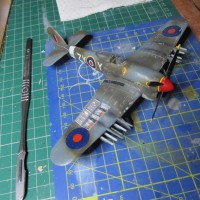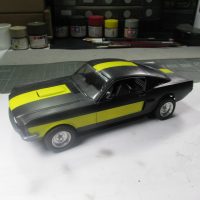.... and now for something completely different: Richard Trevithick's “Pen-y-Darren Locomobile”, the world's first steam locomotive!
A short preface to Richard Trevithick's locomotive from 1804.
Cornwall in the 18th century is described in the sources as a highly inhospitable region and, because of its barren landscape and harsh population, it is known from London as ‘western barbary’. The rocky coasts, buffeted by the stormy Atlantic, were feared by seafarers and were repeatedly the undoing of ships - whose cargo washed ashore then helped to supplement the population's income in a semi-legal manner. The land itself yielded meagre returns - but if you went beneath the surface, this harsh land had a rare treasure to offer: Cornwall harboured significant copper and tin deposits, which made mining one of the few profitable lines of business. The miner's enemy, however, has always been water; the deeper they dug, the more urgent the need to pump out the constantly encroaching water became. The efficiency of pumps moved by muscle power had its limits - and this also set the limits for the depths to which the shafts could be driven. By the middle of the 18th century, however, steam engines had been developed that were powerful enough to be used effectively for dewatering mines.
The scenario described here is the reason why the inhospitable, lonely west of England was the birthplace of the first steam ‘locomobile’: around 1800, the rhythmic breathing of steam engines and the coking chimneys of the pump houses, which kept the mines free of water in an incessant race, had already been part of the rugged hills of Cornwall for decades. Moreover, time had raised an energetic breed of people who were both entrepreneurial and innovative enough to recognise the possibilities of new technologies.
Richard Trevithick, ‘a giant of steam’
Richard Trevithick, born into a family of miners in 1771, was the son of a mining engineer employed at Dolcoath Mine. Appointed at a young age to the East Stray Park Mine, he made remarkable improvements to the high-pressure steam engines used to drive the pumps. His most decisive innovation of this period is considered to be the development of an engine operating at high steam pressure and the associated high-pressure boilers. However, the young Trevithick not only made a name for himself by following familiar paths, but also as a lateral thinker and innovator: as early as 1797, he surprised everyone with his first steam carriage model, which was powered by a heated iron rod instead of a fire engine and could therefore only cover short distances. However, the idea did not seem to let him go: a road ‘locomotive’ that could also transport passengers followed shortly afterwards. This construction, which became known as the ‘Puffing Devil’, could reach a speed of around 8 kilometres per hour including passengers, a remarkable achievement. However, its range was also limited.
A third attempt to make a steam-powered self-propelled carriage profitable also failed: in 1803, a ‘Steam Carriage’ designed by him, a stagecoach equipped with a steam engine, caused quite a stir, but was not convincing as a practicable alternative to conventional carriages.
The ‘Pen-y-Darren Engine’. The world's first locomotive
By this time, however, Trevithick had already laid the foundations for the invention that would write him into the history books - and which is presented here as a model. In 1802, he had designed and built a high-pressure steam engine for a Welsh ironworks in Pen-y-Darren and mounted it on a chassis. A special feature of this steam engine was the long pipe: he was the first to use the principle of the suction pressure pipe, which forced the air out of the cylinder exhaust to the outside and thus gave the boiler the necessary heat. This innovation was to prove its worth right up to modern steam locomotives. A second special feature was the flywheel mounted on the side and connected to the push rod, which helped to move the piston over the respective dead centres of the motion sequence. This striking detail was common in the stationary steam engines of the time, but was soon to disappear again in the further evolution of steam locomotives.
Essentially, however, the ‘Pen-y-Darren locomotive’ was a high-pressure steam engine mounted on wheels - a conversion that can be seen as a beacon of world-changing innovation!
He sold the patent for this vehicle and the engine itself to the owner of the ironworks, Mr Samuel Homfray, in 1803. The new owner was so impressed by his new acquisition that he soon made a risky bet with business friends: his steam locomotive would be able to pull ten tonnes of iron over a distance of 15.7 kilometres to neighbouring Abercynon!
21 February 1804 was the day on which the bet was honoured. Homfray was delighted: within four hours and five minutes, the puffing, steam-spitting and screeching locomotive not only pulled the required ten tonnes of iron, but also 70 (!) men in five wagons over the 15 kilometres. With this achievement, the ‘Pen-y-Darren engine’ is recognised as the first steam locomotive and could go down in the history books. However, the design itself was only used for a short time. As it proved to be too heavy for the rails, which were designed for horse-drawn carriages, it was soon converted back into a stationary steam engine and was to be operated as such for years to come.
Richard Trevithick built another steam locomotive before moving on to other topics. In 1808, he built a simplified version of the ‘Pen-y-Darren locomotive’, which did away with the large flywheel in favour of a stationary cylinder that transmitted power directly to the drive wheels by means of a crank rod. This locomotive, christened ‘Catch me if you can’, was used as a kind of fairground attraction: on a narrow circular track at the site of what would later become Euston station in London, people could pay to watch the locomotive on its circular track or even dare to take a ride. However, interest in the ‘Catch me if you can’ did not last long: when public interest began to wane, Trevithick sold the locomotive after just two years of operation.
For the erratic inventor and entrepreneur that Trevithick was, this closed the chapter of steam locomotives, in which he had made such ground-breaking achievements. In subsequent projects, he worked on further high-pressure steam projects, some of them with great success. For example, an attempt was made to tunnel under the Thames - which was not yet successful at the time - but steam cranes, steam excavators and screw propulsion on steam ships were also designed and tested. In 1816, Trevithick set off for Peru after investing in the development of steam pumps for silver mining. However, this turned out to be a rather unfortunate decision: a civil war that broke out soon after his arrival and the associated financial speculation cost him his assets, causing him to return to England in 1826. He was no longer able to build a new life. Completely destitute, he died in 1833 at the age of 54 in the Dartford poorhouse.
Kit and model
In their more than sixty years of existence, the kit moulds have followed a rather tortuous path through several new editions by different manufacturers until 1996, when they were issued for the last time. The original kit was made by Gakken, a manufacturer from Japan in the early 1970s.
As luck would have it, I stumbled across the kit in the original Gakken edition at a modelling fair this year - and knew the minute I saw it that I simply had to have it! Now I am in no way a locomotive connoisseur, but I was fascinated by the historical setting and the kit, which I remember from my childhood.
The construction itself was quite simple and quick. The parts have a pleasant level of detail that still seems appropriate today and are moulded surprisingly cleanly. I only replaced the already somewhat corroded metal rods that were included for the wheel axles and the push rods with new metal rods, otherwise I built from the box.
Several Alclad II metal tones were used for the paintwork, the most important of which were ‘German Tank Grey’ and ‘Gunmetal’. The rest of the colouring was done with pastel chalks and various Vallejo colours. I made the tracks on which the ‘Pen-y-Darren locomotive’ stands in the illustrations with the backgrounds myself from two strips of plastic glued at right angles to each other; those on which the model is presented on its base come from the kit. I revitalised the base itself a little with diorama material.
For me, building the ‘Pen-y-Darren’ was a really insightful, short and very entertaining excursion into a modelling corner that I hadn't even known about before. After this experience, I now see steam locomotives in a different light - and I'm quite sure that one or two thematic excursions will follow! And who knows, maybe this will lead to a real trip to the storm-tossed cliffs of Cornwall?



























A very nice and interesting history and great work on the locomotive. It's not a model one sees done often.
@rosachsenhofer - Fantastic build. I love how the modeling experience leads to researching the subject and a deeper understanding of both the specific subject and the culture in which it emerged from. Very cool writeup!
Very interesting subject and sharp build. Thanks for sharing!
Great article, Roland! You should consider a compilation of your articles here; it would make for good reading! What an interesting and well-built project @rosachsenhofer!
You should consider a compilation of your articles here; it would make for good reading! What an interesting and well-built project @rosachsenhofer! 
Very nice build of a key piece of technological history.
Excellent model and very interesting history, Roland!
Congratulations!
Wonderful work. Thanks for sharing.
History I was unaware of. Thanks! The model;'s great too - definitely "not something one sees every day."
Nice build of an interesting subject. And very interesting "history lesson" too. But how was it fired while it was running?
Maybe this video can bring some clarity - a lot is reconstruction without exact plans, which leaves room for improvisation, I think!
A very interesting historical topic and supported by a beautiful build, Roland @rosachsenhofer
Well done.
The small town of Camborne in Cornwall was a centre of the tin mining industry, and still has a tin mining school. There is a statue of Trevethick outside the town library.
1 attached image. Click to enlarge.
I would like to thank you all for your interesting and much appreciated feedback! I am very pleased that this topic and my comments on it have been well received. I like to deal with the historical background of my modelling topics - and writing about them is also a pleasant way of doing this. I really appreciate it when this is well received. Thank you for your motivating words!